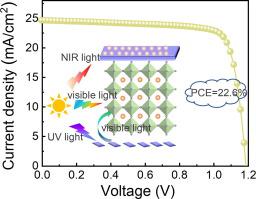Chemical Engineering Journal ( IF 15.1 ) Pub Date : 2022-01-20 , DOI: 10.1016/j.cej.2022.134792 Zhichong Shi 1 , Donglei Zhou 1 , Yanjie Wu 1 , Gencai Pan 2 , Wen Xu 1 , Nan Wang 1 , Shuainan Liu 1 , Rui Sun 1 , Le Liu 1 , Xinmeng Zhuang 1 , Yuhong Zhang 1 , Siyu Lu 3 , Hongwei Song 1

|
The light loss caused by the incomplete utilization of the solar energy spectrum is a key factor that impedes the photoelectric conversion efficiency of perovskite solar cells (PSCs). Hence, reducing the light escape through enhancing the utilization of ultraviolet (UV) light, and expanding the response of PSCs in the near-infrared (NIR) range is the key factor to further improve the photoelectric conversion efficiency (PCE) of PSCs. However, there is a lack of literature on engineering UV and NIR light harvesting at the same time. Herein, the NaYF4:Ce,Tb@NaYF4 core–shell nanocrystals with efficient photon downconversion ability from UV to visible are designed to be embedded in the electron transporting layer (ETL), which serves as the photon downconverters and defect passivators, successfully improving the light response in both UV and visible region. The CIGSe quantum dots (QDs) with excellent infrared light harvesting ability, together with the plasmonic Au nanorods (NRs), are assembled in the hole transporting layer (HTL) to expand and improve the NIR light harvesting. The light response of the PSCs was successfully broadened to the NIR region from 800 to 920 nm. As a result, the champion PSC device insulating with NaYF4:Ce,Tb@NaYF4 nanocrystals and CIGSe QDs demonstrates a remarkably increased PCE from 19.38% to 22.60%. The modified PSC devices also demonstrate highly improved UV and long-term stability. This work suggests a universal strategy to improve the UV and near-infrared light harvesting of PSCs, which is of great importance for fabricating PSCs with response to full spectrum.
中文翻译:

双界面工程可改善紫外和近红外光收集,以实现高效稳定的钙钛矿太阳能电池
太阳能光谱利用不完全造成的光损失是阻碍钙钛矿太阳能电池(PSCs)光电转换效率的关键因素。因此,通过提高紫外(UV)光的利用率来减少光逃逸,扩大PSCs在近红外(NIR)范围内的响应是进一步提高PSCs光电转换效率(PCE)的关键因素。然而,缺乏同时工程紫外和近红外光收集的文献。其中,NaYF 4 :Ce,Tb@NaYF 4具有从紫外到可见光的有效光子下转换能力的核壳纳米晶体被设计成嵌入电子传输层(ETL)中,该层用作光子下转换器和缺陷钝化剂,成功地改善了紫外和可见光区域的光响应。具有优异红外光捕获能力的 CIGSe 量子点 (QD) 与等离子体金纳米棒 (NRs) 一起组装在空穴传输层 (HTL) 中,以扩展和改善近红外光捕获。PSC 的光响应成功地扩大到从 800 到 920 nm 的 NIR 区域。结果,冠军PSC器件用NaYF 4 :Ce,Tb@NaYF 4绝缘纳米晶体和 CIGSe 量子点的 PCE 从 19.38% 显着增加至 22.60%。改进后的 PSC 器件还表现出高度改进的紫外线和长期稳定性。这项工作提出了一种通用策略来改善 PSC 的紫外和近红外光捕获,这对于制造响应全光谱的 PSC 非常重要。


























 京公网安备 11010802027423号
京公网安备 11010802027423号